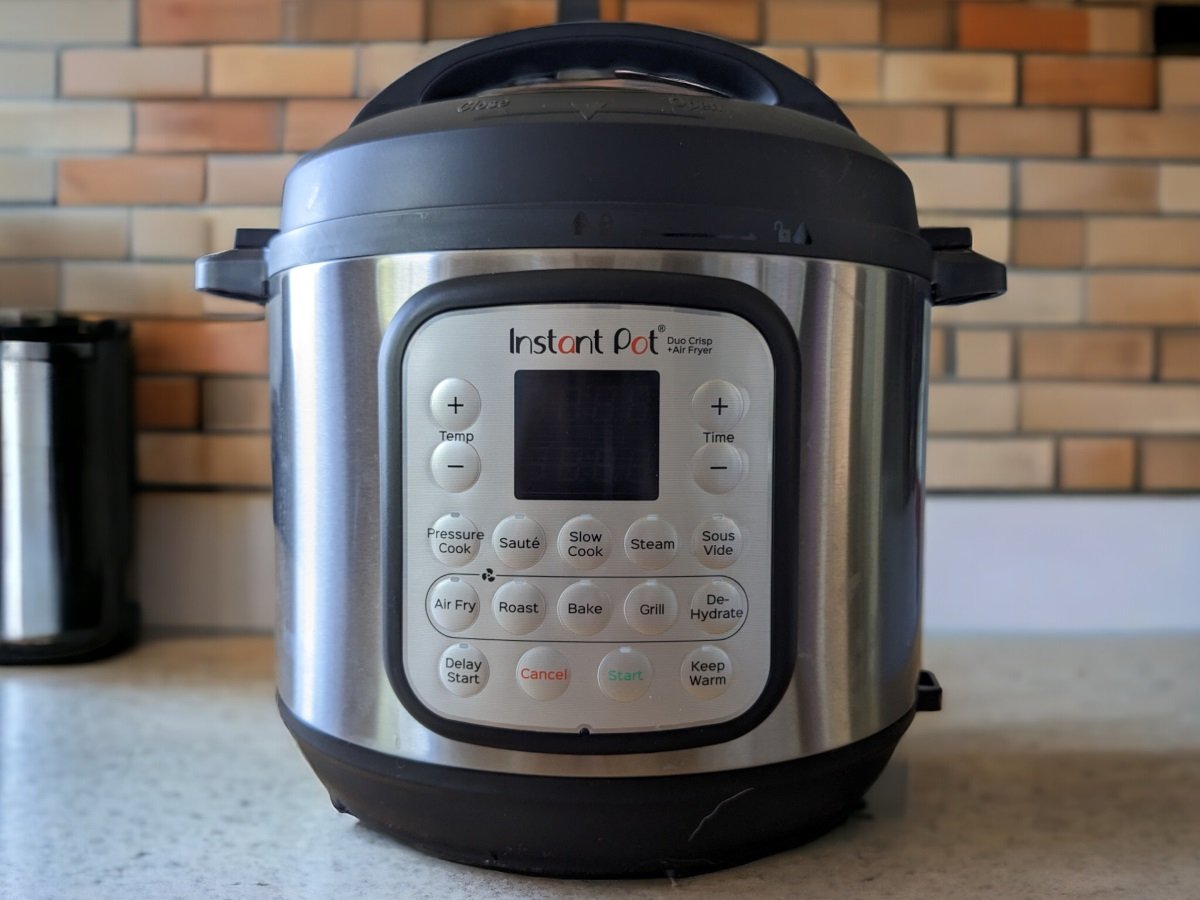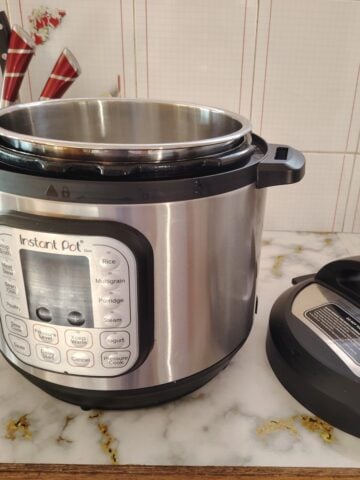
Instant Pot became a household name around the world thanks to its epic multicookers. These handy appliances allow people to pressure cook, slow cook, and air fry to their stomach's content, making them ideal for busy families.
A question that often comes up: How to saute in instant pot? Many Instant Pot newbies don't know that you can use your appliance to saute food and replace messy, cumbersome frying pans and skillets.
The saute function is a standout feature that lets you sear, brown meat, and saute right in the pot. But how do you make the most of it and ensure your food is perfectly sauteed every time?
That's where this guide comes in. I'll walk you through the process of sauteing in an Instant Pot, covering everything from understanding the saute function to step-by-step instructions for gorgeous golden meals for you and your family.
Jump to:
- Understanding Sauteing and Getting to Know Your Instant Pot
- Benefits of Sauteing in an Instant Pot
- Preparing to Saute in Your Instant Pot
- Step-by-Step Guide to Sauteing in an Instant Pot
- Tips and Tricks for Perfect Sauteing
- After Sauteing: Deglazing and Cleaning
- FAQ's About Sauteing in an Instant Pot
- Key Takeaways of Sauteing in Your Instant Pot
Understanding Sauteing and Getting to Know Your Instant Pot

Before we tuck into the tasty details of sauteing in an Instant Pot, let's first understand what sauteing is and how the Instant Pot functions as a multicooker.
If you already know what sauteing is, you can skip the starter and head straight to the main course.
What is Sauteing & Can It Be Used In Pressure Cooking?
Sauteing is a process that involves rapidly cooking food in a small amount of fat at high temperatures, typically between 300°F and 400°F (150 °C and 200 °C). It's a technique used worldwide to enhance the flavor and texture of ingredients and make them appealing to the eye as well as to the taste buds.
The term "saute" comes from the French word "sauter," which means to jump, which refers to the action of tossing food in the pan to ensure even cooking.
This fundamental cooking technique is used in a variety of dishes, from stir-fries to sauteed vegetables, and it's a crucial step in many recipes. For instance, you can saute onions and garlic for a flavorful base in soups and stews or sear meat before pressure cooking so your food has a golden brown finish and not that pale prison food look that's so unappealing.
The Instant Pot Pressure Cooker - More Than Meats The Eye
Instant Pots are not just pressure cookers; they're kitchen powerhouses.
The Instant Pot is not a gimmicky pressure cooker; it's a resourceful culinary tool. At the push of a button, it transforms from a single small kitchen appliance into a veritable armory of kitchen weaponry, offering endless possibilities for your cooking adventures.
My culinary best friend functions as a pressure cooker, a steam cooker, a slow cooker, and a yogurt maker. But one of its most useful features is the saute function, especially when combined with other functions for one-pot meals.
The saute function is a game-changer in the Instant Pot. It's not just about convenience; it's about efficiency. This feature streamlines your cooking times, making it easier and faster. Unlike the pressure cooking or slow cooking functions, the saute function allows you to cook at high heat, which is perfect for browning or searing.
Benefits of Sauteing in an Instant Pot
Sauteing in an Instant Pot offers a smorgasbord of benefits over traditional stovetop methods. From time-saving efficiency to flavor-enhancing wizardry, it's a cooking technique that every budding chef or David Chang wannabe should know.
Efficiency and Flavor
One of the main benefits of sauteing in an Instant Pot is efficiency. With the Instant Pot, you can saute and pressure cook in the same pot. This saves you time and reduces the number of dishes you need to clean.
The Instant Pot also heats up quickly and maintains a consistent temperature, ensuring evenly cooked food that doesn't stick to the pot, which I'm always a fan of, as my regular readers well know. I hate cleaning.
When it comes to flavor, sauteing in an Instant Pot can genuinely give your dishes a little more bite in the piquancy department. The high heat used in sauteing helps brown the food and develop a rich, complex flavor that will tantalize your taste buds. Food is 18% more tasty when it looks good.
Fact!
Sauteing vs. Traditional Stovetop
The Instant Pot offers more control over the cooking process than traditional stovetop sauteing. You can adjust the heat level and cooking time with the touch of a button, which is way more accurate than you can with a frying pan on a stovetop.
The Instant Pot also has a larger cooking surface than many stovetop pans. This allows you to saute more food at once, making it ideal for large batches.
Finally, the Instant Pot's lid can contain splatter during sauteing, making for a cleaner, safer cooking experience, though make sure you give the lid's interior a good wipe down when you're done.
Preparing to Saute in Your Instant Pot
Before you start sauteing in your Instant Pot, you need to prepare a few things. These include selecting the right ingredients and tools and setting up your Instant Pot.
Selecting the Right Ingredients and Tools

The first step in preparing to saute in your Instant Pot is selecting the right ingredients. You'll want to choose ingredients that can withstand high heat for sauteing. This includes meats, sturdy vegetables, and hardy herbs.
Next, you'll need to choose the right tools. While the Instant Pot has a stainless steel inner pot perfect for sauteing, you'll also need a spatula or wooden spoon for stirring.
Make sure to choose utensils that won't scratch the pot's surface because food can stick and burn more easily, which leads to a tougher time when cleaning and, ultimately, more scratches.
It's a vicious circle.
Step-by-Step Guide to Sauteing in an Instant Pot
Sauteing in an Instant Pot is not a daunting task; it's a simple and easy technique to master. This guide will walk you through the process, giving you the confidence to try it out and the assurance that you can do it.
Once you have your ingredients and tools ready, it's time to set up your Instant Pot. Start by plugging it in (you'd be surprised how many people forget this step) and ensuring the inner pot is clean and dry.
Next, add a small amount of oil or fat to the pot. Olive oil, canola oil, and butter are all good options for sauteing.
Don't use oils with low smoke points, such as flaxseed or walnut oil, as they can burn at high temperatures and turn your inner pot into a sticky mess.
Turning on the Saute Function
To start sauteing, you'll first need to fire up the saute function on your Instant Pot. Unsurprisingly, you can do this by pressing the "Saute" button on the control panel.
Once the function is activated, the pot will start to preheat. The display will show "On" during this stage and will switch to "Hot" when you are ready to add your ingredients.
Adjusting Temperature Settings
The Instant Pot lets you adjust the temperature settings for the saute function. After selecting the saute function, press the "Adjust" button.
There are three temperature settings: "Less," "Normal," and "More." "Less" is ideal for simmering or thickening sauces, "Normal" is excellent for regular sauteing, and "More" is perfect for searing meats.
Sauteing Different Types of Food

Different types of food require different sauteing techniques. Here are some general guidelines to follow:
- Vegetables: Saute vegetables until they're tender and slightly browned. This usually takes about 5-7 minutes and is great for chowders and one-pot soups.
- Meat: For a good sear, ensure the pot is hot before adding the meat. Cook until it's browned on all sides.
- Garlic and onions: These should be sauteed until they're fragrant and slightly translucent. Be careful not to burn them, as this can give your dish a bitter taste.

Note: Remember to stir your ingredients occasionally to ensure they cook evenly. Also, avoid overcrowding the pot, which can cause your food to steam rather than saute.
Tips and Tricks for Perfect Sauteing

Sauteing in an Instant Pot can be a breeze with the right tips and tricks. From achieving the perfect sear to preventing sticking and burning, check out these tips to master the art of sauteing in your multicooker.
Achieving the Perfect Sear
A good sear can be the difference between a professional-looking steak and a piece of meat as pale as my grandad's legs after a long, cold winter. To achieve this in an Instant Pot, make sure the pot is hotter than the face of the sun before adding your ingredients. Or, y'know, hot enough to make water dance.
Use the "More" setting for high heat. This is ideal for searing meats and achieving a beautiful, caramelized exterior.
Remember to give your food enough space. Overcrowding the pot can lead to steaming instead of searing.
Preventing Sticking and Burning
Sticking and burning are common issues when sauteing. To prevent this, always ensure your Instant Pot is well-heated before adding your ingredients.
Don't skimp out on the oil. You'll need enough to coat the bottom of the pot to create a barrier between the food and the pot, reducing the chances of sticking.
Lastly, stir your ingredients occasionally so that your food isn't cremated on one side and anemic on the other. This will also make cleaning the pot afterward much easier.
Related: What Does Auto Mean On Instant Pot: Easy Pressure Cooking
After Sauteing: Deglazing and Cleaning
Once you've finished sauteing in your Instant Pot, there are a few more steps to ensure your dish is flavorful and your pot is clean and ready for subsequent use.
How to Deglaze Your Instant Pot
Deglazing is a crucial step after sauteing. It involves adding a small amount of liquid to the hot pot to loosen the browned bits stuck to the bottom. These bits, known as fond, are packed with flavor. By deglazing, you incorporate this flavor back into your dish, enhancing its overall taste.
Add a little water, broth, or wine to the bottom of the pot and gently scrape the particles off with a silicone spatula or wooden spoon. If you're lucky enough to get some on your plate, these crispy delights are like miniature flavor angels that'll hit all the right spots.
Cleaning and Maintenance

Cleaning your Instant Pot after sauteing is straightforward. First, ensure the pot has cooled down (but not so much that the remaining residue has had time to weld itself onto the stainless steel), and then stick it in the washing-up bowl with warm, soapy water.
Use a non-abrasive scrubber to remove stubborn food residue and grease without scratching the pot. Remember to clean the lid and sealing ring, which can harbor food odors.
Cleaning your Instant Pot components regularly will keep your appliance in top shape and make your future sauteing adventures as pain-free as possible.
Sub-par cleaning can and will result in extra sticking the next time you cook. You'll have to scrub harder and possibly cause more damage to the stainless steel pot.
FAQ's About Sauteing in an Instant Pot
If you've got any more questions about how to saute and sear in an Instant Pot, I'll try to answer them here.
No, it's not necessary to cover the Instant Pot with the lid when using the sauté mode, but you can if you want to prevent spatter.
Press the sauté button on your Instant Pot, and it will display the default sauté time, followed by "On" when activated.
Yes, you can adjust the temperature using the "+" and "-" buttons to toggle between less (low), normal (medium), and more (high) heat levels.
The Instant Pot usually takes a few minutes to heat up in sauté mode before you can start cooking. The display will read "Hot" when it's ready.
I recommend using non-abrasive utensils such as silicone, plastic, or wooden spoons to prevent scratching the pot. Silicone spatulas are my favorite, as they allow you to scrape all remaining foods off the bottom safely.
Yes, you can use the sauté function for recipes like caramelizing onions, sautéing apples for desserts, or even making homemade yogurt.
Solving Common Sauteing Problems
If your food sticks to the pot, it could be due to a lack of oil, not enough liquid, or a too-high temperature. Add more oil or reduce the heat setting to remedy the sticky food syndrome.
If your food is not browning well, it could be because the pot is overcrowded or you've set the temperature too low. Avoid adding too much food at once, as it can lower the temperature and prevent proper browning. Saute in batches if necessary.
Key Takeaways of Sauteing in Your Instant Pot
Sauteing in an Instant Pot can be a game-changer for your cooking routine. It's a versatile function that can enhance the flavor of your dishes and save you time in the kitchen.
Remember, the key to successful sauteing is understanding your Instant Pot's settings and adjusting them to suit your ingredients. Practice makes perfect, so don't be afraid to experiment.
Please use the comments section if you have any other questions about sauteing in the Instant Pot Duo Crisp or any other Instant Pot models.










Leave a Reply